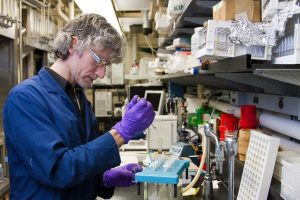Mycelium Insulation: Fungal Tech Reducing Vehicle Emissions
In today’s world, sustainability has become a pressing issue. From plastic pollution to climate change, it is clear that something needs to change. As technology continues to advance, more innovative and eco-friendly solutions are being developed. One such solution is Mycelium Insulation, a revolutionary material made from fungi that is reducing vehicle emissions. In this article, we will delve into what Mycelium Insulation is and how it is making a positive impact on the environment.
The Birth of Mycelium Insulation
Mycelium Insulation is a product of Ecovative Design, a bio-materials company founded by Eben Bayer and Gavin McIntyre in 2007. The idea for this innovative insulation came from observing the growth of fungi in the forest. These tiny organisms have the remarkable ability to break down organic matter and turn it into a strong and durable structure. This inspired Bayer and McIntyre to use fungi to create a sustainable and eco-friendly insulation material.
How Does Mycelium Insulation Work?
Mycelium Insulation is made from mycelium, the vegetative part of fungi that grows out into the surrounding environment. Fungi are fed a sustainable diet of corn stalks, husks, and other agricultural waste, making it incredibly environmentally friendly. The mycelium is then placed in trays or molds and given specific conditions to grow. As it grows, it forms a 3D structure, creating a durable and lightweight material.
Benefits of Mycelium Insulation
Mycelium Insulation has numerous benefits, both for the environment and for consumers. Firstly, it is entirely biodegradable, meaning it won’t end up in a landfill like traditional insulation materials. It also has excellent thermal resistance, which means it can keep heat in during colder months and keep it out during warmer months. This can result in significant energy savings for homeowners and businesses alike. Additionally, Mycelium Insulation is lightweight, making it easy to transport and install, reducing transportation emissions.
Mycelium Insulation and Vehicle Emissions
While Mycelium Insulation has primarily been used in the construction industry, it is now making its way into the automotive industry, specifically for vehicle insulation. Vehicle emissions play a critical role in contributing to air pollution and climate change. By using Mycelium Insulation in vehicles, manufacturers can reduce the emissions produced by their cars.
Vehicle emissions occur when fuel is burned in an internal combustion engine, which produces harmful gases like carbon monoxide, nitrogen oxide, and hydrocarbons. Mycelium Insulation helps to absorb these gases due to its porous structure, reducing the amount of harmful emissions that escape from the vehicle. Additionally, Mycelium Insulation can help to improve fuel efficiency, resulting in decreased emissions. This not only benefits the environment but also reduces the cost of fuel for drivers.
The Future of Mycelium Insulation
As the world becomes more aware of the importance of sustainability, the demand for eco-friendly products continues to grow. Mycelium Insulation is just one of the many innovations that are making a positive impact on the environment. It has the potential to revolutionize the construction and automotive industries, reducing waste and emissions, and promoting a more sustainable future.
The Bottom Line
Mycelium Insulation may be a relatively new concept, but its benefits are undeniable. From its biodegradability to its ability to reduce vehicle emissions, this revolutionary material is changing the game when it comes to sustainability. As more industries adopt Mycelium Insulation, it is only a matter of time before we see a significant decrease in emissions and a more sustainable future for generations to come.
So next time you hear the word “fungi,” remember that these tiny organisms are more than just mushrooms growing in the forest. They are nature’s own solution to our ecological problems, and with Mycelium Insulation, we are harnessing their power to make a positive impact on the environment.











